Family name: Liliaceae Juss.
Synonym(s): Calochortaceae Dumort.; Compsoaceae Horan.; Cymbanthaceae Salisb., nom. inval.; Fritillariaceae Salisb.; Medeolaceae Takht.; Scoliopaceae Takht.; Tricyrtidaceae Takht., nom. cons.; Tulipaceae Batsch ex Borkh.
Common name(s): lily family
*Number of genera/species: 15/705
List of genera records in GRIN-Global
fruit or seed
Fruit a septicidalsepticidal:
type of capsular dehiscence, opening longitudinally by separating between the septa of adjacent carpels
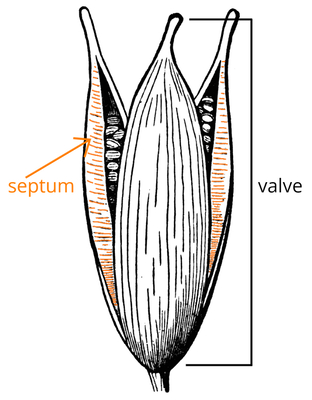 or loculicidalloculicidal:
or loculicidalloculicidal:
type of capsular dehiscence, opening longitudinally through the locules (compare septicidal)
 capsulecapsule:
capsulecapsule:
a dry, dehiscent fruit derived from a compound ovary or berry (Clintonia, Medeola, Prosartes, Streptopus), 4–90 mm long, globoseglobose:
or berry (Clintonia, Medeola, Prosartes, Streptopus), 4–90 mm long, globoseglobose:
3D shape—more or less spherical to angularangular:
to angularangular:
2D shape—having sides that meet at acute or obtuse angles
, tereteterete:
approximately circular in cross section; width and thickness approximately equal
 or angledangular:
or angledangular:
2D shape—having sides that meet at acute or obtuse angles
in transection, sometimes tepals or stylesstyle:
in a flower, the narrow and elongated part of the pistil between the stigma and the ovary; sometimes persisting in fruit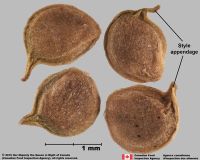 (Prosartes) persistent, winged in some species of Calochortus and Lilium, rarely beakedbeak:
(Prosartes) persistent, winged in some species of Calochortus and Lilium, rarely beakedbeak:
a usually firm, terminal appendage, sometimes tapered , with few to many seeds. Berryberry:
, with few to many seeds. Berryberry:
an indehiscent, fleshy fruit with one or a few to many seeds. The flesh may be homogenous throughout. Or, if the outer part is hard, firm, or leathery, referred to as an hesperidium. Septa are present in some, and the seeds may be arillate or with a fleshy testa.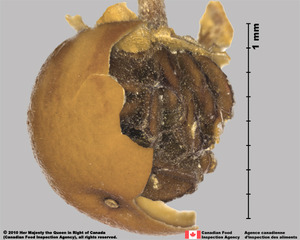 pericarp black, blue, or purple (Clintonia, Medeola) or orange or red (Prosartes, Streptopus), leatheryleathery:
pericarp black, blue, or purple (Clintonia, Medeola) or orange or red (Prosartes, Streptopus), leatheryleathery:
texture—moderately thick, tough, and very pliable
or fleshy. Capsulecapsule:
a dry, dehiscent fruit derived from a compound ovary pericarp usually brown or brownish purple, chartaceouschartaceous:
pericarp usually brown or brownish purple, chartaceouschartaceous:
papery, papyraceous
, often with tightly packed seeds piled upon each other. Pericarppericarp:
fruit wall or fruit coat
in both fruit types shinyshiny:
uniformly reflecting a high proportion of incident light at all angles or dulldull:
or dulldull:
reflecting only a low proportion of incident light, with no apparent sheen , smooth, ridgedridged:
, smooth, ridgedridged:
surface relief—raised, thick ridges, sharp edged or rounded, usually in a series that may cover the entire surface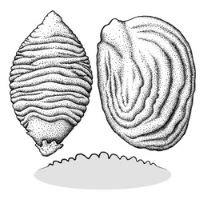 , ribbedribbed:
, ribbedribbed:
surface relief—wide, prominent, linear ridges that are generally rounded and longitudinally situated on the surface , or papillatepapillate:
, or papillatepapillate:
surface relief—bearing minute, distinct, broad-based projections, tapering to a rounded apex , sometimes pubescentpubescent:
, sometimes pubescentpubescent:
surface relief—bearing hairs
(Prosartes, stellatestellate:
star-shaped; with radiating branches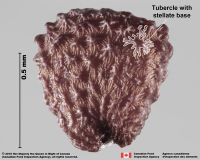 hairs in one species of Tricyrtis).
hairs in one species of Tricyrtis).
Seeds globoseglobose:
3D shape—more or less spherical to angularangular:
to angularangular:
2D shape—having sides that meet at acute or obtuse angles
, often flat or discoiddiscoid:
3D shape—resembling a disc
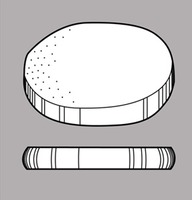 , if discoid often with marginalmarginal:
, if discoid often with marginalmarginal:
at, on, or close to the margin or border
rim, tereteterete:
approximately circular in cross section; width and thickness approximately equal
 or flattened in transection, 1.5–15 mm long. Seeds winged in Cardiocrinum, Calochortus macrocarpus, Fritillaria, Gagea, Lilium, and Notholirion. In Notholirion and Calochortus macrocarpus, wings often narrow or scarcely discernable. ElaiosomesElaiosome:
or flattened in transection, 1.5–15 mm long. Seeds winged in Cardiocrinum, Calochortus macrocarpus, Fritillaria, Gagea, Lilium, and Notholirion. In Notholirion and Calochortus macrocarpus, wings often narrow or scarcely discernable. ElaiosomesElaiosome:
a lipid and protein-rich fleshy structure attached to some seeds and fruits, it attracts ants which then disperse the disseminule (e.g., caruncle in the Euphorbiaceae, the aril (outgrowth of the funiculus) in the Fabaceae)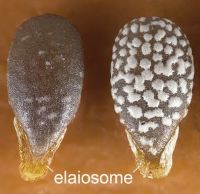 present in Scoliopus and Gagea. RaphaeRaphe:
present in Scoliopus and Gagea. RaphaeRaphe:
a ridge or seam on the seed coat, formed by the portion of the funiculus united to the ovule wall in longitudinally curved ovules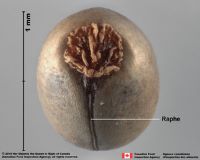 (from micropylemicropyle:
(from micropylemicropyle:
an opening in the integuments of an ovule usually acting as a passage for the pollen tube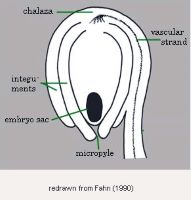 to nearly the chalazalchalaza:
to nearly the chalazalchalaza:
the region at the base of the ovule where the integuments are inserted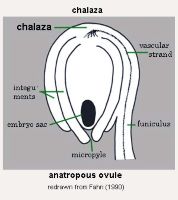 end) present in Scoliopus. Seed coat black, blue, brown, or yellow, shinyshiny:
end) present in Scoliopus. Seed coat black, blue, brown, or yellow, shinyshiny:
uniformly reflecting a high proportion of incident light at all angles , smooth, reticulatereticulate:
, smooth, reticulatereticulate:
surface relief—netted, raised walls or concave grooves forming a net-like surface pattern with flat, concave, or convex interspaces , wartywarty:
, wartywarty:
surface relief—distinct, rounded projections that are large relative to the fruit size; tuberculate, verrucose , ribbedribbed:
, ribbedribbed:
surface relief—wide, prominent, linear ridges that are generally rounded and longitudinally situated on the surface , or groovedgrooved:
, or groovedgrooved:
surface relief—linear depressions that may be single or form a series of grooves over the surface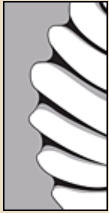 .
.
Embryo very small and little differentiated, 1/5 to 1/12 the length of the endosperm.
Endosperm present.
| Fruit | ||
| Type | capsulecapsule: a dry, dehiscent fruit derived from a compound ovary  , berryberry: , berryberry:an indehiscent, fleshy fruit with one or a few to many seeds. The flesh may be homogenous throughout. Or, if the outer part is hard, firm, or leathery, referred to as an hesperidium. Septa are present in some, and the seeds may be arillate or with a fleshy testa.  |
|
| Size range | 4–90 mm long | |
| Shape(s) | linearlinear: (shape) long, narrow, and uniform in width; (of embryo) embryo is straight and much longer than wide  , globoseglobose: , globoseglobose:3D shape—more or less spherical  , ellipsoidellipsoid: , ellipsoidellipsoid:3D shape—elliptic , angularangular: 2D shape—having sides that meet at acute or obtuse angles , oblongoblong: 2D shape—much longer than broad with nearly parallel sides, corners are rounded  , ovoidovoid: , ovoidovoid:3D shape—ovate  , lanceoloidlanceoloid: , lanceoloidlanceoloid:3D shape—lanceolate , teardrop-shapedteardrop-shaped: 2D shape—widest point is toward one end of the fruit, the other end tapers sharply to a pointed end 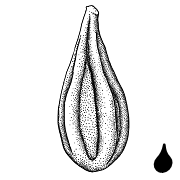 , trigonoustrigonous: , trigonoustrigonous:3D shape—having three faces that meet at distinct angles; triangular in outline , cylindricalcylindrical: 3D shape—a cylinder, with parallel sides and a circular cross-section; tubular or rod-shaped |
|
| Texture | fleshy, chartaceouschartaceous: papery, papyraceous , leatheryleathery: texture—moderately thick, tough, and very pliable |
|
| Surface relief | smooth or ridgedridged: surface relief—raised, thick ridges, sharp edged or rounded, usually in a series that may cover the entire surface  , ribbedribbed: , ribbedribbed:surface relief—wide, prominent, linear ridges that are generally rounded and longitudinally situated on the surface  , papillatepapillate: , papillatepapillate:surface relief—bearing minute, distinct, broad-based projections, tapering to a rounded apex  |
|
| Color(s) | black, brown, blue, purple, yellow, orange, red | |
| Unique features | CapsulesCapsule: a dry, dehiscent fruit derived from a compound ovary  often many seeded with seeds tightly packed and piled upon each other. BerriesBerry: often many seeded with seeds tightly packed and piled upon each other. BerriesBerry:an indehiscent, fleshy fruit with one or a few to many seeds. The flesh may be homogenous throughout. Or, if the outer part is hard, firm, or leathery, referred to as an hesperidium. Septa are present in some, and the seeds may be arillate or with a fleshy testa.  globose, purplish-blue with 12–15 closely packed seeds. globose, purplish-blue with 12–15 closely packed seeds. |
|
| Seed | ||
| Size range | 1.5–15 mm long | |
| Shape(s) | lanceoloidlanceoloid: 3D shape—lanceolate , globoseglobose: 3D shape—more or less spherical  , ellipsoidellipsoid: , ellipsoidellipsoid:3D shape—elliptic , oblongoblong: 2D shape—much longer than broad with nearly parallel sides, corners are rounded  , triangulartriangular: , triangulartriangular:2D shape—three relatively straight sides with distinct corners; more angular than teardrop-shaped  , rhomboid, polygonalpolygonal: , rhomboid, polygonalpolygonal:angular |
|
| Surface relief | smooth, reticulatereticulate: surface relief—netted, raised walls or concave grooves forming a net-like surface pattern with flat, concave, or convex interspaces  , wartywarty: , wartywarty:surface relief—distinct, rounded projections that are large relative to the fruit size; tuberculate, verrucose  , ribbedribbed: , ribbedribbed:surface relief—wide, prominent, linear ridges that are generally rounded and longitudinally situated on the surface  , groovedgrooved: , groovedgrooved:surface relief—linear depressions that may be single or form a series of grooves over the surface  . . |
|
| Color(s) | blue, brown, yellow, black | |
| Unique features | Seeds often flat or discoiddiscoid: 3D shape—resembling a disc  with marginalmarginal: with marginalmarginal:at, on, or close to the margin or border rim, or if not flattened may be appendaged. |
|
| Other | ||
| Embryo | very small and little differentiated, 1/5 to 1/12 length of endosperm | |
| Nutritive tissue | endosperm present | |
North temperate.
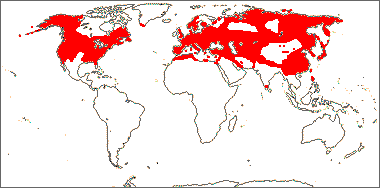
Distribution map courtesy of Angiosperm Phylogeny Website.
Baskin and Baskin 2021Baskin and Baskin 2021:
Baskin C and Baskin J. 2021. Relationship of the lateral embryo (in grasses) to other monocot embryos: A status up-grade. Seed Science Research 31 (3): 199-210. doi:10.1017/S0960258521000209; Dahlgren et al. 1985Dahlgren et al. 1985:
Dahlgren RMT, Clifford HT, and Yeo PF. 1985. The families of the monocotyledons: structure, evolution, and taxonomy. Springer-Verlag, Berlin. 520 pp.; Nooteboom et al. 2021+Nooteboom et al. 2021+:
Nooteboom HP, de Wilde WJJO, Stevens PF, Coode MJE, and Saw LG. 2021+ Flora Malesiana Online. Accessed January 2021–March 2024. URL: https://portal.cybertaxonomy.org/flora-malesiana/; Flora of North America Editorial Committee 1993+Flora of North America Editorial Committee 1993+:
Flora of North America Editorial Committee, eds. 1993+. Flora of North America North of Mexico [Online]. 22+ vols. Flora of North America Association, New York and Oxford. Accessed January-March 2024. URL: http://beta.floranorthamerica.org.; Kirkbride et al. 2006Kirkbride et al. 2006:
Kirkbride JH, Jr, Gunn CR, and Dallwitz MJ. 2006. Family guide for fruits and seeds, vers. 1.0. Accessed September 2020-January 2022. URL: https://nt.ars-grin.gov/seedsfruits/keys/frsdfam/index.cfm .; Kubitzki et al. 1990+Kubitzki et al. 1990+:
Kubitzki K et al., eds. 1990+. The families and genera of vascular plants. 7+ vols. Berlin etc.; Takhtajan 2009Takhtajan 2009:
Takhtajan A. 2009. Flowering plants: Second edition. Springer Nature, Switzerland. 871 pp.; Tutin et al. 1964–1980Tutin et al. 1964–1980:
Tutin TG, Burges NA, Chater AO, Edmondson JR, Heywood VH, Moore DM, Valentine DH, Walters SM, and Webb DA (eds.) 1964–1980. Flora Europaea. 5 vols. Cambridge University Press, Cambridge UK. 2,524 pp.; Watson and Dallwitz 1992+Watson and Dallwitz 1992+:
Watson L and Dallwitz MJ. 1992+. The families of flowering plants: descriptions, illustrations, identification, and information retrieval. Version: 6th Accessed September 2020-September 2022. URL: delta-intkey.com; Zhengyi et al. 2004+Zhengyi et al. 2004+:
Zhengyi W, Raven PH, and Deyuan H. 2004+. Flora of China [online]. 25 vols. Science Press, Beijing China & Missouri Botanical Garden, St. Louis USA. Accessed January–March 2024. http://flora.huh.harvard.edu/china/
*The number of genera and species is based on Christenhusz and Byng 2016Christenhusz and Byng 2016:
Christenhusz MJM and Byng JW. 2016. The number of known plant species in the world and its annual increase. Phytotaxa 261 (3): 201-217. https://doi.org/10.11646/phytotaxa.261.3.1, which may differ from the number of genera in GRIN-Global.